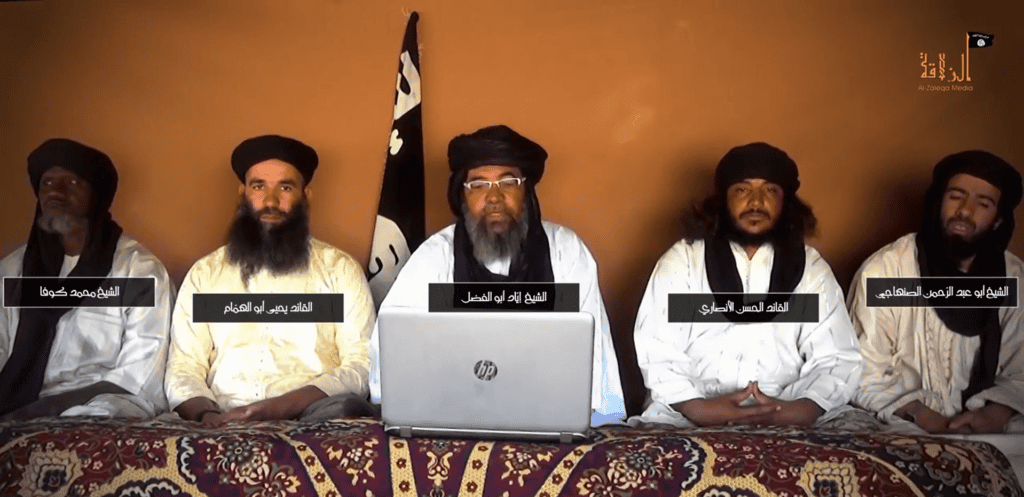
The leaders of four al Qaeda groups have united under a common banner.
The recent merger of several Mali-based al Qaeda groups is bad news for the already unstable Sahel region. The new al Qaeda entity will fuel an emboldened insurgency in Mali and allow for greater coordination throughout the region.
Earlier this month, Ansar Dine, al Qaeda in the Islamic Maghreb’s Sahara branch, Al Murabitoon, and Katibat Macina (also known as the Macina Liberation Front) merged to form Jama’at Nusrat al-Islam wal-Muslimin (the “Group for the Support of Islam and Muslims”).
Iyad Ag Ghaly, a veteran Tuareg jihadist, heads the new entity, which is openly loyal to Ayman al Zawahiri and Abdelmalek Droukdel, the leader of al Qaeda in the Islamic Maghreb (AQIM). [See FDD’s Long War Journal report, Analysis: Al Qaeda groups reorganize in West Africa.]
Each of the constituents in the “Group for the Support of Islam and Muslims” has contributed to a growing insurgency emanating from northern Mali, with more than 250 al Qaeda-linked attacks last year alone. The jihadists’ activity throughout the region in 2016 marked a 150 percent increase over calendar year 2015, when this same consortium of groups was suspected of launching approximately 106 operations.
Ansar Dine claimed over 80 attacks, while AQIM claimed 21. The majority were never claimed, but were attributed to the jihadists. [See FDD’s Long War Journal, Al Qaeda linked to more than 250 West African attacks in 2016.]
Most of these operations were located in Mali’s volatile northern region. However, at least 51 were perpetrated in the southern half of the country. Another 20 occurred in Burkina Faso, Niger and the Ivory Coast.
Therefore, the jihadists had already widened the geographic scope of their operations before the merger. The newly formed “Group for the Support of Islam and Muslims” is likely to increase this threat even further, as better coordination will potentially make it easier to plan operations against their common enemies.
For instance, after the merger between Al Murabitoon and AQIM in late 2015, the latter was able to tap into Al Murabitoon’s resources to conduct raids on hotels in Bamako, Mali, Ouagadougou, Burkina Faso, and in Grand Bassam, Ivory Coast.
All of the constituent groups have engaged in guerrilla warfare, utilizing typical insurgent tactics such as ambushes and bombings with improvised explosive devices (IEDs).
But Al Murabitoon is usually the subgroup that is behind the larger, more spectacular assaults. This includes January’s massive suicide attack on a Malian military base in Gao, which left at least 50 people dead.
Just a week after its launch, the “Group for the Support of Islam and Muslims” reportedly orchestrated a mass casualty assault on Malian troops. Ghaly’s organization has not released a formal statement claiming the raid. But according to the Mauritanian outlet ANI, the jihadists launched the Mar. 5 attack on a Malian army position near Boulkessi in the country’s central Mopti region. At least 13 soldiers were killed and many others wounded.
It is likely that the former Katibat Macina of Ansar Dine was behind the Mar. 5 raid. Katibat Macina (a.k.a. the Macina Liberation Front) is predominately Fulani in ethnicity and is led by Amadou Kouffa, a close ally of Ghaly who fought alongside the jihadists during the takeover of northern Mali in 2012. Kouffa and his men operated as an arm of Ansar Dine prior to the merger. Kouffa appeared in Ghaly’s video announcement earlier this month.
Katibat Macina and another one of Ansar Dine’s battalions, Katibat Khalid bin Walid, have been tasked with operations “south of the river,” which refers to the Niger River. Ansar Dine proper is largely confined to the Kidal region of northern Mali. AQIM’s Sahara branch has several battalions fighting in Mali and its most active unit, the Katibat al Furqan, operates in the Timbuktu region. Al Murabitoon is mainly based in the area surrounding Gao, as well as in neighboring Niger and Burkina Faso.
There have been over 50 al Qaeda-linked attacks in Mali and neighboring countries this year already, according to data compiled by FDD’s Long War Journal. Most of the operations have been carried out inside Mali, mainly in southern half of the country. However, at least 12 have been perpetrated in Burkina Faso and Niger.
Many of the attacks in Burkina Faso are thought to be the work of Ansaroul Islam, a newly formed jihadist group. Ansaroul Islam is allegedly led by an ally of Kouffa, the leader of Ansar Dine’s Katibat Macina. While not confirmed, Ansaroul Islam is possibly a Burkinabe branch of Ansar Dine “in gestation,” according to Menastream. The French publication RFI has alleged that Kouffa radicalized Ansaroul Islam’s leader, Malam Ibrahim Dicko, in northern Burkina Faso.
In posts made on its Facebook page, Ansaroul Islam confirmed that Dicko has met with Kouffa. Jeune Afrique has reported that Dicko initially tried to link up with jihadist groups in northern Mali in 2013, but was arrested by French forces in Tessalit and then subsequently released in 2015.
Although Ansaroul Islam’s place in Ghaly’s joint venture is currently unclear, it is possible, if not likely, that Dicko and his fighters are part of it as well. Indeed, Ansaroul Islam may have been responsible for the aforementioned attack in Boulkessi earlier this month.
Ghaly’s unified entity poses a major security threat not only inside Mali, but also throughout most of West Africa — well beyond Mali’s borders.







